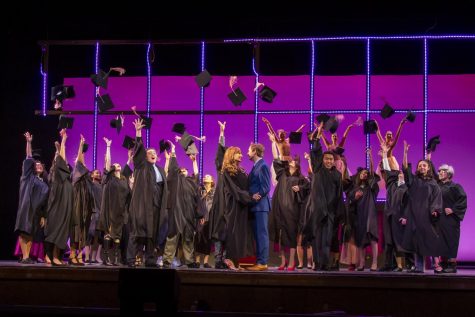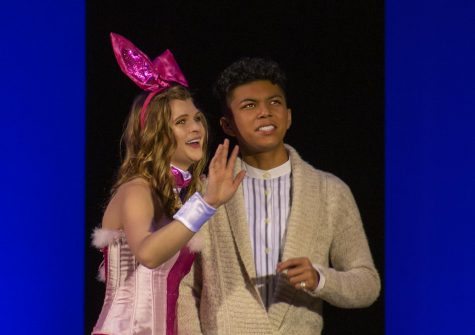The Making of “Legally Blonde”
March 9, 2020
From February 27th to 29th, the musical production of the Bergen County Academies, Legally Blonde, played in the school’s auditorium and received marvellous responses from the audience. Like any other theatrical production, Legally Blonde required the cooperation of numerous groups. The well-rehearsed coordination made the show seamlessly magical for the audience. How was the show put together? Let’s go back to opening night.

It is the day of the first show: the casts are rehearsing the final details of transitions between scenes and the crews are running technical checks. In the pit, there sit 15 student-musicians, making little tweaks to the way they will perform the music as Mr Isecke and Mr Lemma go over their lists of final changes they want to make. For example, some vamps are changed to accommodate transitions and the preference of cast members. One of the advantages of having a live pit orchestra is the flexibility: the music can be adjusted during practice sessions, or even the official performances, to create a seamless, natural experience for the audience. Although, the baritone saxophonist of the pit orchestra, Emily Hashem commented, “I hope we won’t need to during the shows!”
Although Emily has been playing the alto saxophone for years and participates in selective bands in addition to taking lessons, she had to learn the baritone saxophone for the pit orchestra. “Initially, I thought it would be easy to learn the baritone sax,” said Emily, “but it was much harder than I imagined.” Despite these obstacles, all the musicians exceeded in providing the music for Legally Blonde.
Mr Isecke, who conducted the pit orchestra for Act 1 of the show, said that a lot of the work is coordinating between all the components of the musical. “In a typical show,” he said, “there is usually one musical director, who plays the piano at rehearsals or uses an accompanist, works with the singers, and conducts the pit orchestra. In our show, there are five: I conduct Act 1, Mr Lemma conducts Act 2, Mr Spinelli works with singers on their vocals, and we have two pianists that accompany the cast during rehearsals.”
The pit orchestra had rehearsals on every school day except for Wednesday, in addition to after school rehearsals and the sitzprobe—a day where the cast and the pit orchestra work on integrating their parts and making needed adjustments. On the final day, the conductors were confident in the pit orchestra and proud of all the student-musicians for the work they have done.

Likewise, Ms Pero, the director of the show, emphasised the extraordinary amount of cooperation that went into the making of the musical–what she called “an incredibly rich tapestry.” While each person who participates has a unique take on the musical, they must, in the end, tell the same, coherent story. Long before school rehearsals began, Ms Pero worked extensively with the set designer, Kyu Shin, to come up with a mobile and versatile collection of sets. Although this met Ms Pero’s vision of a minimalistic and flexible set, it did require a tremendous amount of work to get the transitions just right. Ms Pero again: “We spent weeks and weeks and weeks creating the transitions, then completely redoing them when we discovered they were too cumbersome…simplifying them, practising them so the audience wouldn’t have to wait for the next scene to start.”
On one end, Nick Rea, the production stage manager (who Ms Pero called “genius…so calm, so brilliant, and so efficient”), made charts after charts detailing the procedure of each transition and redid them all over again when the proposed procedure did not work. Meanwhile, the pit orchestra, crew members, and cast members combined their efforts to make the transitions seamless and efficient.

Additionally, the lighting crew designed the light to bring the focal point to the main plotline while also drawing the attention away from background transitions that might otherwise be distracting. Although the demanding perfectionism might seem extreme, it is what it took to achieve the final, beautiful transitions.
Moreover, Ms Pero and Ms Crochet, the choreographer, had to consolidate their visions of the show. They are responsible for different aspects of staging the show due to their different skillsets: Ms Pero works on the acting and the blocking, or the book scenes, while Ms Crochet directs dance numbers and choreography. Yet, there were crossover scenes in the show on which they collaborated. The numerous “departments”, per se, in the show made it necessary to maximise the efficiency of the limited number of rehearsals, which was accomplished  in the form of what Ms Pero called “a four-ring circus.” The system relied on a rotation, so each actor would always be working with one of the followings: choreography with Ms Crochet, book work with Ms Pero, vocal and music with Mr Spinelli, or joint-rehearsal with the pit orchestra. Following this rigorous schedule, for three straight months, the actors worked tirelessly during in-school and after-school rehearsals (and unlike Courtney, never took a break).
in the form of what Ms Pero called “a four-ring circus.” The system relied on a rotation, so each actor would always be working with one of the followings: choreography with Ms Crochet, book work with Ms Pero, vocal and music with Mr Spinelli, or joint-rehearsal with the pit orchestra. Following this rigorous schedule, for three straight months, the actors worked tirelessly during in-school and after-school rehearsals (and unlike Courtney, never took a break).
The individual efforts culminated to an outstanding production: according to Ms Pero, the tech aspect of the show was pushed beyond what has ever been done at BCA. The show received overwhelmingly enthusiastic and positive receptions, and the ticket sales broke BCA’s box office record. All these were possible, only because of the people who participated in BCA’s Legally Blonde, that are driven as hell. Congratulations to all who worked on the show.






